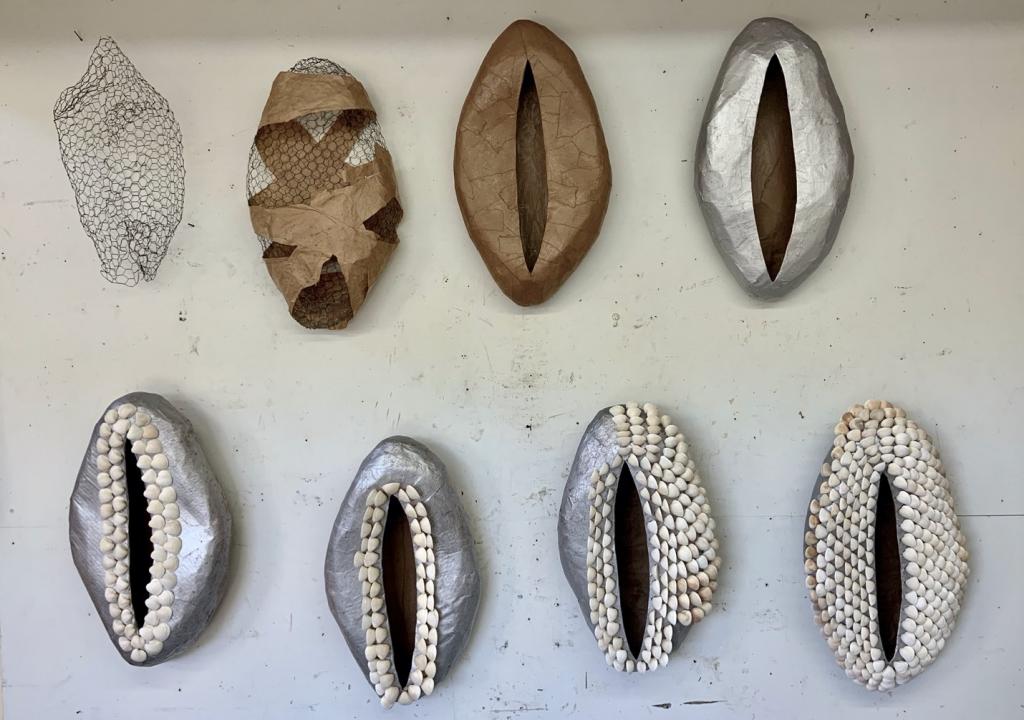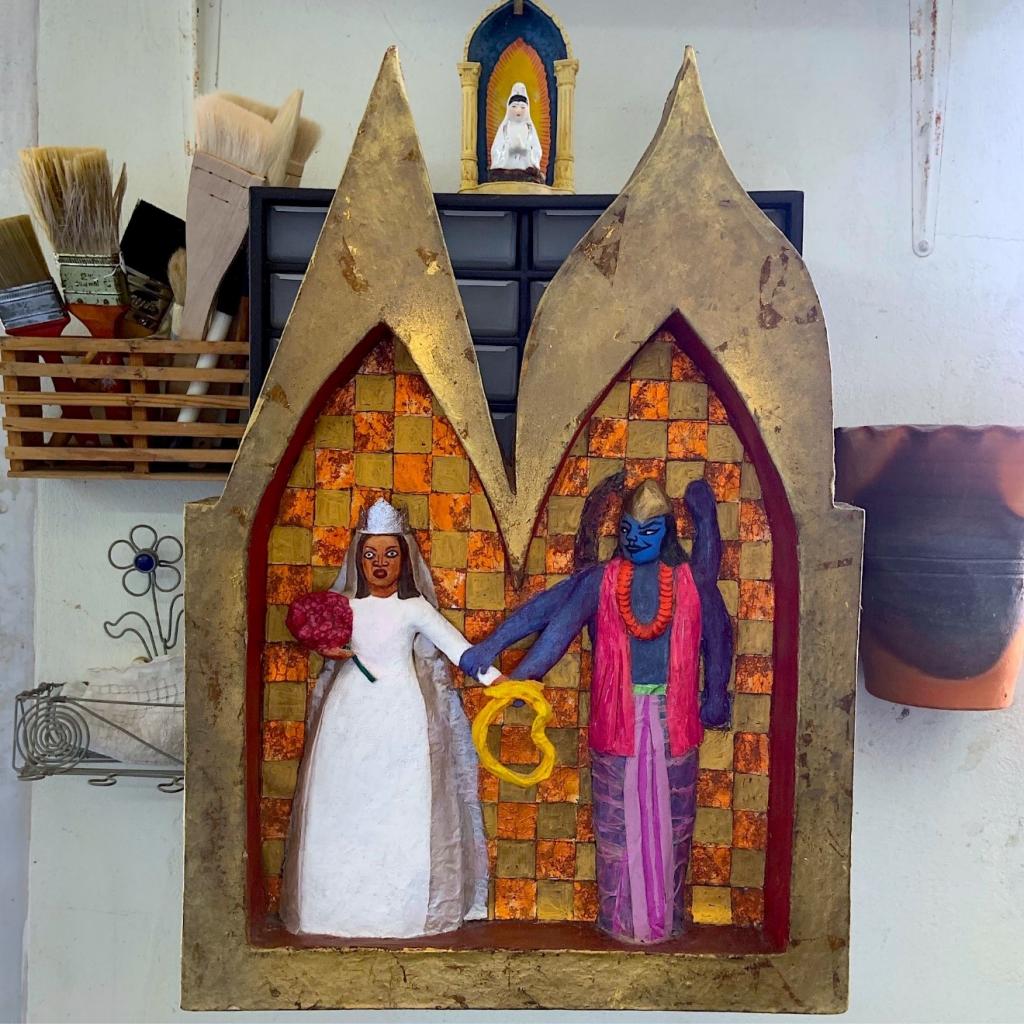
Figure 1. Breath in process. Wendy Nanan’s studio, Port of Spain, 2019. Photograph by the author; used by permission of the artist
A British man taught meditation to Trinidadian artist Wendy Nanan. Wendy and I have chatted frequently over the course of the current pandemic, in part a consequence of the interruption it caused to the opening of her largest solo exhibition to date, Wendy Nanan, at the Art Museum of the Americas (AMA) in Washington, DC. In March I was locked down in Toronto the morning of my flight to the AMA to complete installation, and we have just been waiting since. (Originally scheduled for 19 March–6 September 2020, the exhibition was then slated to open in October and run through the beginning of 2021; currently, the AMA is closed.)
With every phone conversation, I learn more about the notoriously reclusive figure. “My elder sister Chandra was a practicing Buddhist,” she tells me, “and always tried to get me to follow the teachings. I resisted until after her death.” Wendy started attending yoga classes held at the YWCA in Port of Spain, and, impressed by the approach of a visiting British Buddhist monk, she started a near-daily practice. Her artworks Dogen’s Rules, Remember Death, The Stupa of the Hungry Ghosts, and the mudras all document her engagement with this philosophy. “There is a lot of crossover between Hinduism and Buddhism,” she observes. “It is a strange mixture of the exotic of Hinduism without the excess, a pared down kind of Japanese simplicity and austerity.” As are her famous cricket drawings. “Those drawings follow the teachings of zenga, drawing from meditation and release of control,” she explains, “using the intuition and the body instead of thinking too hard. A connection to another world which is already there waiting for us to realize it. When you get into the zone things start to flow.”
And now there is Breath. Wendy has been working on the four pairs of shell and papier-mâché sculptures for over a year (see fig. 1). We filmed her creation of the first one in 2019, and the glue on the eighth piece was still drying when they were packed into containers headed to AMA at the end of February 2020. She has been making sculptures from shells collected along the Atlantic coast of Trinidad for a few years, but her earlier versions of these works were in loud, bright colors. Not so for this work. The idea for the project came while Wendy was watching a nature show on PBS. “There was a shot of a clam caught in the sand, with the tide going out. It was trying to breathe by opening in and out. That image of the clam in motion, as it struggled for life out of the water, has always stayed with me.” She tells me, “[By] experimenting with the angles of how one stuck in the shells, and also by adjusting the depths of the underlying physical structure, I realized that you could create a sense of movement.” Thus the birth of Breath, four pairs of these shells that mimic that clam, struggling to breathe. “As I stood, following the sequence of the pairs of shells, I was myself breathing in and out with them and found it deeply calming and centering, as if in a meditation session,” she says. “I hope Breath will serve audiences in the same way. We all, the whole world, need to take some deep breaths right now.”
Wendy and I often think about the peculiar resonance of Breath with the unforeseen circumstances of the year that is 2020. At no point, of course, did she imagine she would be introducing, or trying to introduce, Breath to audiences during the course of a pandemic in which one’s breath would feel so dangerously tenuous. Who would have thought we too would be in the place of that clam that inspired the piece, struggling to draw and hold breath, sometimes at the risk of life itself? Nor did Wendy imagine that Breath would sit half-installed on the walls of the AMA while all around it would unfold a battle of wills over, as president-elect Joe Biden puts it, “the soul of America.” On the one side, at a five-minute-walk northwest of the AMA, resides Donald Trump (at least when he is not at Mar-a-Lago or on a golf cart), willing gaslighter-in-chief toward the expansion of white supremacist violence. On the other, and all around the museum, have been the endless streams of protestors that make up the astonishingly effective Black Lives Matter (BLM) movement. And the event that sparked this year’s climactic round: a man in Minneapolis who calls out “I can’t breathe” just before his murder at, literally, the hands of police.
The video footage of George Floyd’s plea for air forced a kind of reckoning with the historical fact of antiblack violence that is foundational to the Americas—all of it, including Canada and the Caribbean—not seen for half a century and a worldwide response with broad implications. In Trinidad and Tobago, multiple, supportive rallies were held for the movement in what, at least through social media, seemed to be a near-universal statement of solidarity. But in the wake of these came T&T’s general elections in August and a campaign that revealed the continuing challenges of confronting racism.

Figure 2. Wendy Nanan, Idyllic Marriage, 1986. Papier-mâché and acrylic, 21× 15 × 4 in.
Artist’s studio, Port of Spain, 2019. Photograph by the author; used by permission of the artist
Depressed about the way the T&T election campaign was endlessly race-baiting—though I did not have a dog in the race—I called Wendy a day after the result. “Do you remember the elections of 1986?” I asked her. That was the Great Hope year for Trinidad and Tobago. After what had been essentially single-party rule for all of its existence as a country, in 1986 T&T saw a multiracial party come to power in a landslide victory, a moment in which it felt like, to quote the calypso, “all ah we is one.” “I remember going to the meetings at the Savannah,” Wendy told me. “There was a real sense of change in the air, everybody wanted change.” She doesn’t recall any connection between what was going on politically and her practice, but it is telling that one of her most renowned pieces, Idyllic Marriage, which put into form creolization’s tenuous accommodation of multiple cultural forms, was made that year (fig. 2). Idyllic marries a Hindu god, possibly Vishnu or Krishna, to the Catholic La Divina Pastora inside a half-temple, half-church structure. The couple’s exasperated facial expressions revel that this is not an easy marriage. Nor were the politics of 1986, but for a moment, we were full of hope—I was an adolescent, so hope came easy. I was surprised to learn that it was only in 1986 that a Hindu was first appointed to a cabinet post in Trinidad, despite Hindu being the religion of more than one-quarter of its population. Newspapers reported that the swearing in of the new deputy prime minister, Basdeo Panday, a former sugarcane workers union president, was held up because the President’s House contained no copy of a Hindu text for him to hold in place of the Bible. In 2001 I was again surprised, and this time also heartbroken, when Panday (who had become prime minister in 1995) quit the government and the multiracial, prolabor coalition fell apart.
Two decades later, I am surprised yet again, this time by the level of race-baiting and racial animosity the 2020 T&T general election dredged up. Usually Trinis live very well with each other. Compared to the plethora of ethnonationalist warfare worldwide, Trinidad and Tobago has been exceptional in its robust, relative peacefulness. Colonial doctrines on race hang over the country’s politics but not with the intensity or violence that characterizes neighboring Guyana. Perhaps owing to the quick and easy circulation of opinions on digital platforms, however, accusations and other racialized noises about Trinidad and Tobago’s elections, many of them entirely justified, seem louder than usual. I get taken in by them too, and one evening I announce my disappointments, anxieties, and worries to Wendy in rapid-fire succession: Was the election about anything at all? Don’t you think people get bamboozled into racial tribalism because it’s a way of avoiding attention to class? Wealthy Afro-, Indo-, Syrian, and white Trinis have a lot more to answer for together, don’t they? Isn’t the race talk all about stopping poor rural Indo- and poor urban Afro-Trinis from recognizing how mutual their interests actually are? Isn’t it the geography of Trinidad and the sheer amount of traffic that makes every pocket an island of its own, so close to one another but still so cut off from each other? People have no real sense of how power is divided in the country, do they? Will there ever be a 1986 moment again?
“Breathe,” Wendy reminds me.
Weeks pass and the fluster recedes.
Andil Gosine, Professor of Environmental Arts and Justice at York University (Toronto), is curator of Wendy Nanan at the Art Museum of the Americas; the exhibit represents the first time the museum has dedicated its three main galleries to a Caribbean woman artist. Nanan is a Trinbagonian artist best known for her decades-long practice of drawing cricketers at games she attends and for her large papier-mâche sculptures that explore themes such as cultural hybridity, creolization, and spirituality. AMA is currently working toward organization of visits to the exhibition by appointment. Check for updates at the museum’s website.